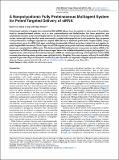A nonpolycationic fully proteinaceous multiagent system for potent targeted delivery of siRNA
Author(s)
Liu, DV; Yang, NJ; Wittrup, KD
DownloadPublished version (643.9Kb)
Terms of use
Metadata
Show full item recordAbstract
© 2014 The American Society of Gene and Cell Therapy. Protein-based methods of targeted short-interfering RNA (siRNA) delivery have the potential to solve some of the problems faced by nanoparticle-based methods, such as poor pharmacokinetics and biodistribution, low tumor penetration, and polydispersity. However, protein-based targeted delivery has been limited to fusion proteins with polycationic peptides as siRNA carriers, whose high charge density in some cases results in undesirable biophysical and in vivo properties. Here, we present a fully proteinaceous, multiagent approach for targeted siRNA delivery to epidermal growth factor receptor (EGFR), using a nonpolycationic carrier for siRNA. Each agent contributes a fundamentally different mechanism of action that work together for potent targeted RNA interference. The first agent is an EGFR-targeted fusion protein that uses a double-stranded RNA-binding domain as a nonpolycationic siRNA carrier. This double-stranded RNA-binding domain fusion protein can deliver siRNA to the endosomes of an EGFR-expressing cell line. A second agent delivers the cholesterol-dependent cytolysin, perfringolysin O, in a targeted manner, which enhances the endosomal escape of siRNA and induces gene silencing. A third agent that clusters EGFR increases gene-silencing potency and decreases cytolysin toxicity. Altogether, this system is potent, with only 16 nmol/l siRNA required for gene silencing and a therapeutic window that spans two orders of magnitude of targeted cytolysin concentrations.
Date issued
2014-05-13Department
Massachusetts Institute of Technology. Department of Chemical Engineering; Massachusetts Institute of Technology. Department of Biological Engineering; Koch Institute for Integrative Cancer Research at MITJournal
Molecular Therapy - Nucleic Acids
Publisher
Elsevier BV